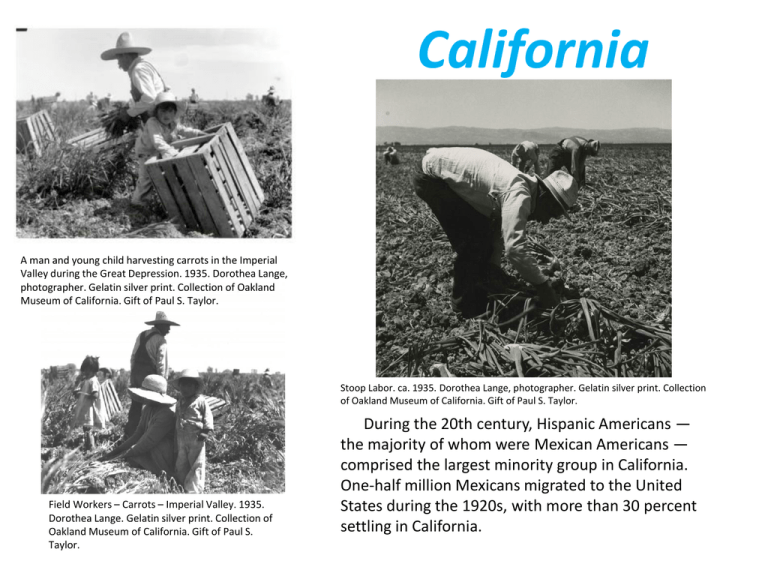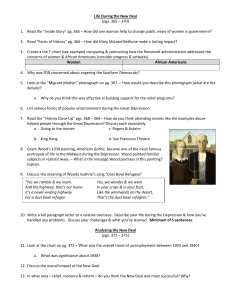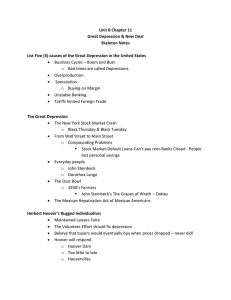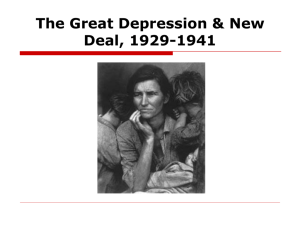Module-1-lesson-5-california-immigration-and-great
advertisement

California A man and young child harvesting carrots in the Imperial Valley during the Great Depression. 1935. Dorothea Lange, photographer. Gelatin silver print. Collection of Oakland Museum of California. Gift of Paul S. Taylor. Stoop Labor. ca. 1935. Dorothea Lange, photographer. Gelatin silver print. Collection of Oakland Museum of California. Gift of Paul S. Taylor. Field Workers – Carrots – Imperial Valley. 1935. Dorothea Lange. Gelatin silver print. Collection of Oakland Museum of California. Gift of Paul S. Taylor. During the 20th century, Hispanic Americans — the majority of whom were Mexican Americans — comprised the largest minority group in California. One-half million Mexicans migrated to the United States during the 1920s, with more than 30 percent settling in California. Dust Bowl Refugees After suffering through several years of severe drought and joblessness, farm workers from Texas, Oklahoma, Arkansas and Missouri began arriving at the fruit and vegetable fields of the San Joaquin Valley in the mid-1930s, looking for work. Known generically as "Okies," between 300,000 and 400,000 migrated to California. Between 1933 and 1935, wind-generated dust storms produced clouds of blowing top soil in western Kansas and in the panhandles of Oklahoma and Texas. The press labeled those coming into California "Dust Bowl" refugees because of this phenomena. Although many of them found temporary employment, living conditions were harsh, and tents or patched-together shacks provided shelter for the families. Read more : http://www.ehow.com/info_8284654_california-1930s.html Mexican and Mexican American migrant farm workers expected conditions like those pictured as they sought farm work in California and other states in the early 1900s. At that time, the Mexican Revolution and the series of Mexican civil wars that followed pushed many Mexicans to flee to the United States. Many U.S. farm owners recruited Mexicans and Mexican Americans because they believed that these desperate workers would tolerate living conditions that workers of other races would not. Mexican and Mexican American workers often earned more in the United States than they could in Mexico's civil war economy, although California farmers paid Mexican and Mexican American workers significantly less than white American workers. By the 1920s, at least three quarters of California's 200,000 farm workers were Mexican or Mexican American. Mexican apricot pickers. June 22, 1935. Dorothea Lange, photographer. Gelatin silver print. Collection of Oakland Museum of California. Gift of Paul S. Taylor When shelters were provided for migrant farm workers, they were usually spartan shacks. Dirt floors were common, as was the lack of functional walls, roofs, and doors. Camps would only rarely have running water. Usually, water had to be carried from a river or ditch, the presence of human or animal waste and farming chemicals in the unfiltered water a constant danger. Often, farm owners charged rent even for such inadequate and dangerous shelters. This photograph, however, is not just an image of the past. Today, farm workers are still fighting farm owners who do not provide basic, humane living and working conditions Imperial Valley – People in Camps. 1935. Dorothea Lange, photographer. Gelatin silver print. Collection of Oakland Museum of California. Gift of Paul S. Taylor. The Great Depression of the 1930s October 29, 1929, was a dark day in history. "Black Tuesday" is the day that the stock market crashed, officially setting off the Great Depression. Unemployment skyrocketed--a quarter of the workforce was without jobs by 1933 and many people became homeless. President Herbert Hoover attempted to handle the crisis but he was unable to improve the situation. In 1932, Franklin Delano Roosevelt was elected president and he promised a "New Deal" for the American people. Unemployment and Relief During the Great Depression, many people lost their jobs as factories and businesses closed. Both public and private programs tried to help those who had no money. At first, people believed it was a disgrace to accept public assistance. The Great Depression changed that attitude. People realized that anyone—neighbors, friends and family—could lose jobs, money and homes. Government and private welfare increased. President Roosevelt created "The New Deal" with many programs to help people. 1. Herbert Hoover was president when the Great Depression began. 2. The Wall Street Crash of 1929 was one of the main causes of the Great Depression. This stock market crash was the most devastating crash in the history of the United States. On “Black Tuesday,” October 29, 1929, the stock market lost $14 billion, making the loss for that week an astounding $30 billion. It took 23 years for the stock market to hit the high it was at before the crash. 3. As news of the stock market crash spread, customers rushed to their banks to withdraw their money, causing disastrous “bank runs.” People who had been very wealthy lost everything they had and some committed suicide. Many companies went out of business and huge numbers of people lost their jobs. 4. People who lost their homes often lived in what were called “Hoovervilles,” or shanty towns, that were named after President Herbert Hoover. There was also “Hoover Stew” which was the name for food handed out to the poor at soup kitchens. “Hoover Blankets” were newspapers that were being used to cover people like a blanket. “Hoover Hogs” were jack rabbits that were used for food, and “Hoover Wagons” were broken down cars that were pulled by mules. Facts about the Great Depression 5. Some people who became homeless would ride on railroad cars, because they didn’t have money to travel. Many of these people traveled together and were called hobos. 6. Almost half of the children who were living in the United States at that time did not have enough food, shelter, or medical care. Many schools closed down entirely. At least 200,000 children took to riding the rails either with their parents or as orphans. 7. African Americans, Native Americans, Mexican Americans and women were discriminated against during the Great Depression. They were looked at as the groups that could take jobs away from white men. 8. Severe drought and dust storms made the Great Depression even worse, because it dried out farmlands and forced families to leave their farms. The drought and dust killed tens of thousands of animals and some people. Facts about the Great Depression of the 1930s How the Depression Affected Children What was it like growing up during the Great Depression? For many people, life was a daily struggle. At the peak of the Depression, 25% of the nation's workers -- one out of four -- were unemployed. No job meant no money to pay the mortgage or buy food and clothes for the family. Times were hard whether you lived in a city or on a farm, whether you were an adult or a child. Families unable to pay the mortgage lost their homes and farms. As a result, about 250,000 young people were homeless in the early years of the Depression. Many became nomads, traveling the highways and railways. Mexican Immigrant in the Depression The Great Depression of the 1930s hit Mexican immigrants especially hard. Along with the job crisis and food shortages that affected all U.S. workers, Mexicans and Mexican Americans had to face an additional threat: deportation. As unemployment swept the U.S., hostility to immigrant workers grew, and the government began a program of repatriating immigrants to Mexico. Immigrants were offered free train rides to Mexico, and some went voluntarily, but many were either tricked or coerced into repatriation, and some U.S. citizens were deported simply on suspicion of being Mexican. Migrant Workers The photographs show Mexican migrant workers in California agriculture. Families (like the one whose car has broken down on the road) faced rough living conditions in the fields. The photograph of field shacks constructed of tin cans is a good example. Title: Migrant family of Mexicans on the road with car trouble, February, 1936. Creator/Contributor: Lange, Dorothea Date: February, 1936. Contributing Institution: UC Berkeley, Bancroft Library Title: Migratory Mexican field worker's home, March, 1937. Creator/Contributor: Lange, Dorothea Date: March, 1937. Contributing Institution: UC Berkeley, Bancroft Library The farmworkers who remained struggled to survive in desperate conditions. Bank foreclosures drove small farmers from their land, and large landholders cut back on their permanent workforce. A great number of Mexican American farmers discovered they had to take on a migratory existence and traveled the highways in search of work. Many found temporary stability in the migrant work camps. The camps provided housing, food, and medicine for migrant farm families. The camps also provided an unexpected benefit. In bringing together so many individual farm families, they increased ties within the community. Many residents began organizing their fellow workers around labor issues, and helped pave the way for better living conditions. Although farming was an important source of employment for Mexican immigrants, by the end of the 1930s Mexican Americans were established throughout the American workforce. Mexican immigrants and their descendants could be found in most of the industries of the Southwest, including ranching , mining, and the railroad. Carmen Carter Remembers Turkey Farming In 1929 Orlo and I had been married two years and had a year old son, Douglas. We were just nicely getting started in the turkey raising business on his parents' farm near Bridgeton. We had about a thousand young turkeys that spring and we bought feed on credit during the growing season and paid for it when we sold the turkeys at Thanksgiving time. But that year was different. The newspapers were full of news about bank closing, businesses failing, and people out of work. There was just no money and we could not sell the turkeys. So we were in debt with no way out. But when we read about the bread lines and soup kitchens in the cities, we felt we were lucky because we raised our own food. Our house was rent free, just keep it in repair. Our fuel, which was wood, was free for the cutting. Then our second child, Iris, was born and our biggest expense was doctor bills. However, this too was solved when our doctor agreed to take turkeys and garden produce for pay. About that time my husband and a friend started operating a crate and box factory near Maple Island. After expenses they were each making about a dollar a day. Food was cheap. Coffee was 19 cents a pound, butter 20 cents, bacon the same, with a five pound bag of sugar or flour about 25 cents. Gasoline was five gallons for a dollar so for recreation we would get into our 1926 Overland Whippet and go for long rides. We also had an Atwater Kent radio we could listen to when we could buy batteries for it. I had always liked to write poetry so I decided to submit some to Grit, a weekly newspaper. I was delighted when they accepted them and paid me $2 each for them. That money bought a large bag of groceries at that time. I continued to write for Grit for several years.





